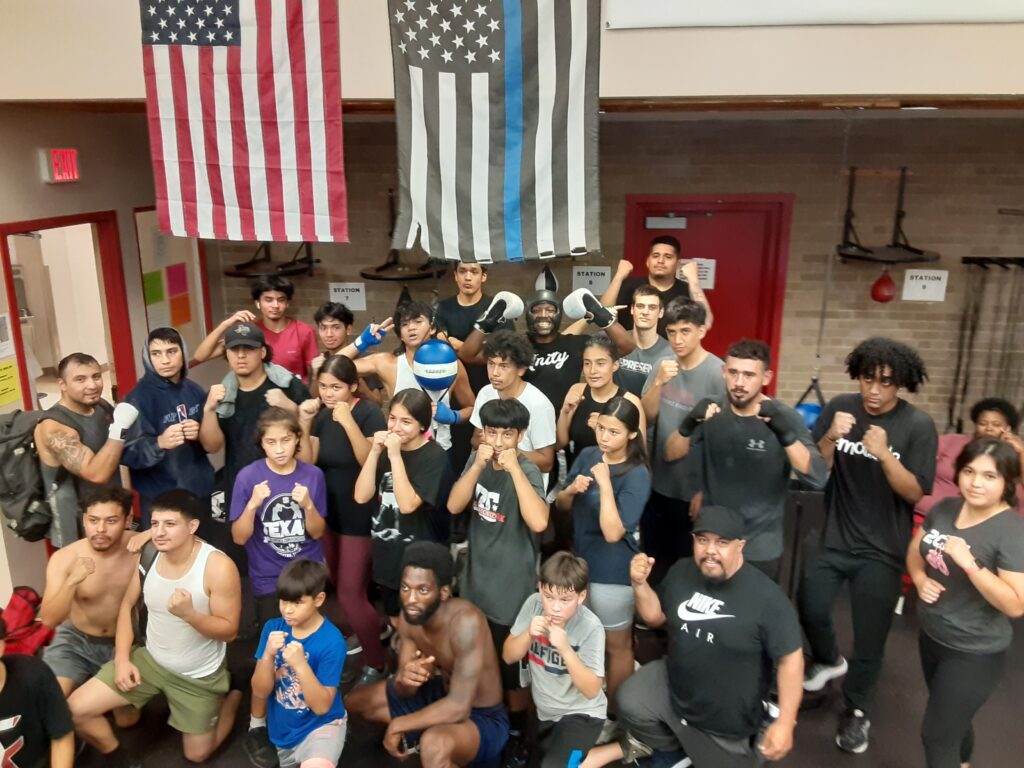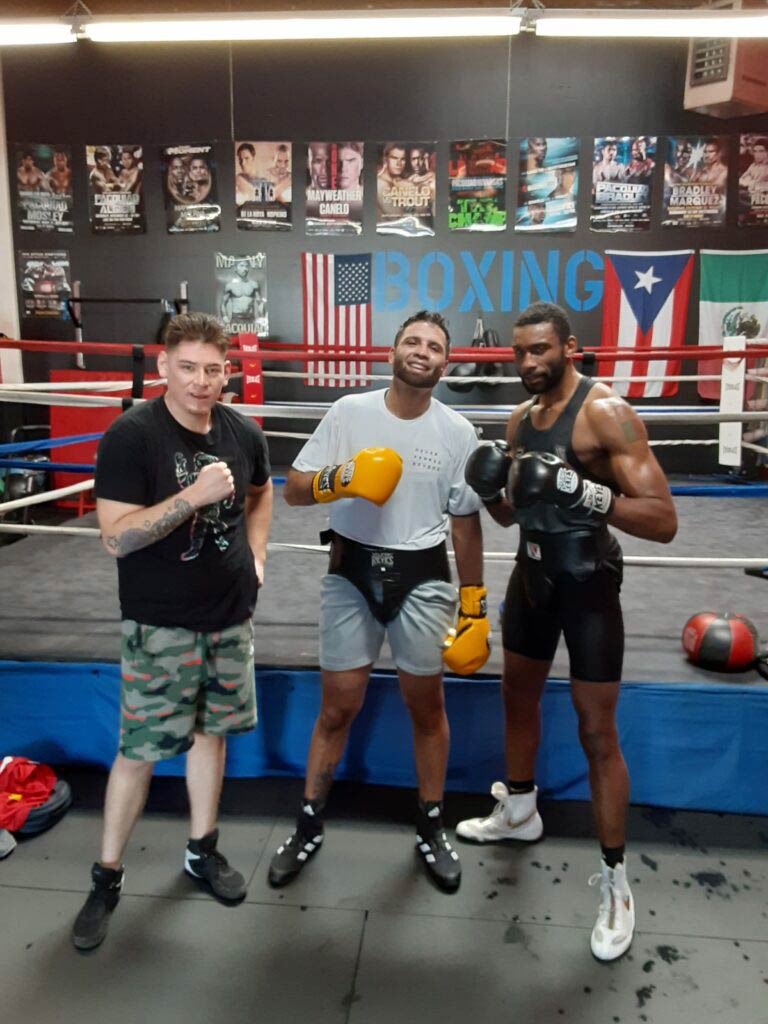About
The Dallas Fight Club amateur boxing program is highly structured and quite demanding, requiring discipline, commitment, and attention to detail. This is in consideration that club members will participate in athletic competition which, if held within the United States, is to be conducted in cooperation with and run under the auspices of USA Boxing Inc.
A non-profit organization overseen by the United States Olympic Committee, USA Boxing affords properly licensed athlete’s 8-40 years of age [40+ for Masters Boxers] necessary medical insurance and therefore the opportunity to participate in competitive based training or sanctioned events.
Such events include local, regional, state, or national competitions with all roads leading to the Pan American Games, the World Amateur Championships, and or the Olympics. These are lofty ideals which require as do many of life’s worthwhile endeavors focus, passion, and dedication.
Having said that, one must first register with and become licensed by a USA Boxing approved organization such as the Dallas Fight Club to from the ground up learn the sport’s basic fundamentals.
However, whether an individual reaches amateur boxing’s highest level or not isn’t the most pressing of concerns. What is of prime importance is that we encourage youth and young adults to become their absolute best, striving for excellence in all pursuits whether in or out of the ring.
Program Benefits
Maximizing cardiovascular fitness levels and therefore one’s mental acuity, the Dallas Fight Club competitive curriculum is the quintessential character builder as well as confidence booster. Serving as a venue for the positive release of energy and frustration, our program is noted as a proven delinquency deterrent, the beneficial impact of which is both astounding and well documented.

This may contradict the mind-set of those who wrongly ascertain that the sport of amateur boxing promotes violent behavior. Quite the contrary as whether formerly anti-social or aggressive trained boxers abilities are rather tested and proven in the ring so that individuals are more restrained with the desire to publicly display anger or retaliate when confronted or insulted either diminished or non-existent.
Propagating solid work-ethic, daily training regimens also promote the understanding that skills acquisition in the gym involve characteristics necessary for achievement outside the gym. And whether or not one encounters genuine success within the sport, the process of trial and error of its own accord imparts critical life lessons to include learning the value of patience, poise, and dedication.
As to the competitive nature of what is essentially a combat sport, amateur boxing diminishes one’s fear so that practitioners develop an innate ability to function under adverse conditions. This increases the likelihood that an individual shun negative or self destructive peer-pressure so that via better decision making youth are more apt to avoid certain of life’s pitfalls.
Above all else amateur boxing fills a void, as the sport’s many attributes help to develop within young people the social and interpersonal skills lacking in current school curriculums. These are in fact traits by which today’s major employers seek out prospective employees, this as opposed to selection based on academic achievement alone.
Come what may there are simply no losers in the amateur program as partakers become equipped with the tools to take life head on with necessary side-effects to include improved school performance, increased awareness, gained confidence, to finally produce more focused, motivated, and goal-oriented beings.
Training Regimen
Program participants upon gym arrival start with 5 to 10 minutes of warm-up activities which from day-to-day vary. Examples of warm-ups include rope jumping, jogging, dumbbell/medicine ball exercises, calisthenics, speed bag work, line drills, shadowboxing, mirror exercises, the stationary bike, and a host of other drills whether done solely or in combination.
Once warm-up is complete athlete’s proceed to doing approximately 5 minutes of light flexibility stretching all parts of the body. This promotes injury prevention, improves reaction time and fluidity of movement, to finally increase range of motion and therefore dexterity and power.
The next phase of training depending on the progression level of the athlete could either involve tactical shadowboxing, mirror or line drills, 1-on-1 punch mitt work with coaches, counter-punch drills, contact sparring, interval and or circuit training at various stations whether it be the heavy or light bag stations, floor or ring work. Both the contact sparring and counter-punch drills require head-gear, a foul-protector, mouthpiece, and padded sparring gloves.
As it relates to the program itself it must be noted that curriculum activities whether attempted individually or with a fellow athlete are to be accomplished in a progressive manner. This means that starting with the sport’s fundamentals boxer’s do not proceed to the more refined tasks until they’ve consistently demonstrated an ability to deploy the basic and or prerequisite skills.
Fundamentals include learning stance, directional footwork, and striking technique, initially to be done in concert with line drills. Such drills allow for the combining of punches, head movement, and footwork to develop balance in motion. Once line drill exercises become proficient, team members then progress to shadowboxing and or transfer learned skills to light or heavy bags maintaining proper technique at all times.
With an initial emphasis on proper form to subsequently add speed and power, heavy bag workouts build strength and stamina, teaching boxers how to put weight and leverage into their striking motion. On the other hand light bags such as air filled speed bags or double-end bags cultivate rhythm and timing, ultimately via hand eye coordination developing pinpoint accuracy so as to land the most forceful of blows.
In addition, because double end bags secured both at the top and bottom with an elastic cord strike back, athletes learn to implement a variety of defensive tactics which when converted to offense, aka the catch and counter, would prove indispensable in the ring whether during sparring or competition.
Once athletes become familiar with a beginning level routine they are then introduced to interval training, an aspect which see’s the periodic alternation between boxing drills and conditioning exercises. Maximizing one’s overall fitness level, interval training in addition enhances core stability, fosters breathing patterns, and promotes transition speed.
To further sharpen skills, increase energy capacity, and develop hand, eye, and foot coordination, the use of punch mitt and power shield floor workout routines are employed where boxers work individually with coaches in order to become more well-rounded athletically.
Upon effectively demonstrating skills on the punch pads participants then proceed to in tandem execute offensive and defensive maneuvers in predetermined sequences. Known as counter-punch drills, this exercise is supervised and requires necessary protective equipment.
Once proficient at counter-punch drills sparring is the next step, conditioning athlete’s physically and mentally for the rigors of competition. [Note: a registered boxer will not be entered into competition until he or she satisfactorily demonstrates an ability to be competitive during supervised training]
Sparring not only maximizes one’s physical condition, but affords participants the opportunity to execute learned tactics under competitive type circumstances. Furthermore, contact sparring develops poise under fire, totally reinforcing the training experience in that whatever deficiency one possesses in the ring, the opportunity to make needed corrections presents itself in practice.
As training sessions near conclusion, boxers run sprints to augment oxygen carrying capabilities while we also incorporate sports specific calisthenic and plyometric strength and conditioning exercises using natural body weight and or varied equipment to develop explosiveness. This is followed by cool down and more thorough stretching with the best time to increase flexibility being towards the end of a workout when the body is totally loose.
Licensing
To become a licensed amateur boxer or even a professional for that matter an individual must first undergo a physical examination to be administered by a medical doctor [MD] or doctor of osteopathy [DO]. This is to ensure one is free from pre-existing conditions that would prohibit participation and or prove detrimental when exposed to the rigors of competition.
Once cleared by way of handing in completed USA Boxing Physical forms issued by the Dallas Fight Club [Professionals Must Hand in Combat Sports or Athletic Commission Documentation to the appropriate State Agency], 2 passport size photos and a copy of a birth certificate or passport face page must then be provided [to include fingerprints on the pro level] to finally submit the current annual registration fee whether $65 or $77 depending on athlete age [$60 for pro’s]. At this juncture you’ll be issued a license without which one cannot participate in amateur or professional programming.
An amateur license affords holders the option to participate in competitive based training or sanctioned competition by way of providing necessary medical, surgical, hospital, and dental coverage up to a total of $25,000. This includes a $1,000 deductible if possessing primary coverage or a $2,500 deductible without such coverage.
Please Note: Individuals must first demonstrate competency as well as excel within our Recreational ranks before becoming eligible to participate in Amateur Boxing Program activities or events.
Training Gear
The Dallas Fight Club will either provide you if qualified with personal training gear or guide you in the purchase of necessary equipment through online distributors. We oppose buying merchandise from local sporting goods stores which generally carry inferior quality equipment that will expose individuals to a risk of injury. Required items include training gloves, a mouthpiece, hand wraps, head-gear, a foul-protector, and competition trunks, jersey, and shoes.
Social Media
In order to help promote programming so as to benefit as large a sector of the community as possible we’ve taken to social media to get our message out. Having said that, we maintain accounts with and regularly post content on Facebook, Instagram, Twitter, and YouTube where via the latest in photo and video members of the general public can view our internal workings while individuals can also obtain regular training or special event updates on these very same platforms.
To connect to Facebook, Instagram, or Twitter, just click on the icons located at the top of this or other web pages while to view our YouTube channel please Click Here.

